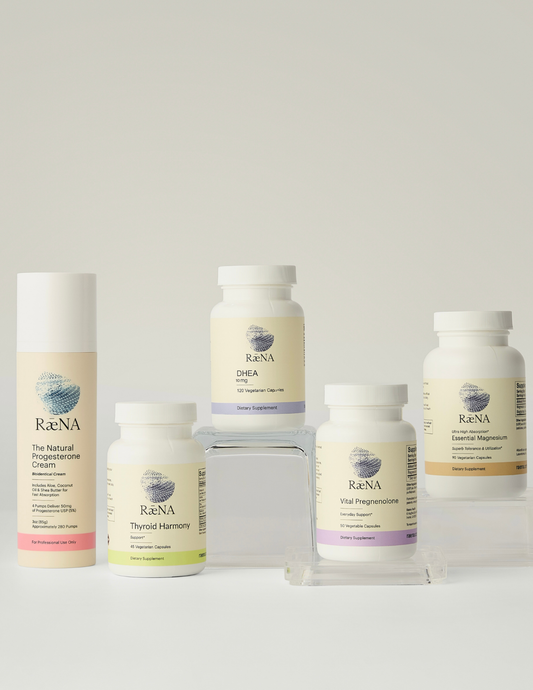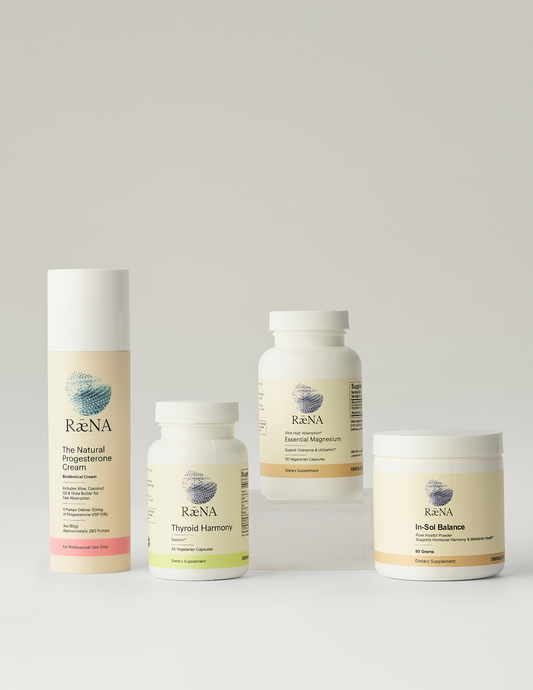The ALL Method
The ALL METHOD: How to Use Hormones in Midlife
The ALL Method is a thoughtful approach to hormone therapy that prioritizes the body’s natural balance. The key is to first build a strong hormonal foundation before considering adding in estrogen. Not medical advice, just a framework.
Progesterone
As women age, progesterone declines up to 12 times more rapidly than estrogen. During perimenopause, estrogen levels become erratic, fluctuating unpredictably. By the time menopause sets in, ovarian estrogen production drops sharply, but fat tissue increases its own estrogen output to compensate.
This is why supporting the body with progesterone is so important throughout the aging process. When progesterone levels are too low, estrogen can become dominant, setting the stage for a wide range of hormonal symptoms. Progesterone is often the first line of defense—it balances estrogen, soothe the nervous system, and protect vital systems throughout the body, from the uterus to the brain. Low progesterone has been linked to PMS, fibroids, endometriosis, fibrocystic breasts, cancer, hot flashes, night sweats, PCOS, and sleep disturbances.

Importantly, progesterone can be safely used on its own and without estrogen. A 2023 randomized, placebo-controlled trial from CeMCOR of perimenopausal women, found that oral micronized progesterone significantly reduced perimenopausal interference with daily life, without increasing depression or causing adverse effects.
Progesterone can be reliably measured through blood testing. For women who are still menstruating, the ideal time to test is between days 19 and 21 of the cycle—the mid-luteal phase—when progesterone levels should peak. If levels are low during this window, it may indicate a hormonal imbalance.
For women who are no longer cycling, it's often safe to assume progesterone is low, as production drops significantly with age. In many cases, testing isn’t necessary, since progesterone deficiency tends to show up through clear, recognizable symptoms like irregular periods, mood changes, poor sleep, or signs of estrogen dominance. This is why treatment is frequently based on symptoms and life stage rather than lab values alone.
Bioidentical progesterone is available in 50mg, 100mg, 150mg, and 200mg doses, in both cream and capsule form. For women who still have menstrual cycles, it’s common to cycle progesterone from days 14 to 28 of the cycle to mimic the body’s natural rhythm. In menopause, progesterone can be used daily to help ease symptoms like hot flashes, night sweats, anxiety, and sleep disruptions. It can also be applied vaginally to support tissue health, dryness, or thinning.
Bioidentical progesterone is considered very safe with no known toxic effects. Researchers have been unable to establish a toxic threshold for natural progesterone, meaning even large amounts have not produced harmful outcomes. This safety profile makes it a unique option in hormone therapy: protective for the body and well-tolerated by most women. It may temporarily shift your cycle dates as your body adjusts, but it doesn’t carry toxic risks.
When some women start taking progesterone, they experience symptoms of estrogen dominance, like breast tenderness or irregular bleeding. This is known as “estrogen kickback.” This happens because progesterone can mobilize stored estrogen from tissues, suddenly increasing circulating estrogen levels. If a small dose of progesterone disrupts your sleep or makes you feel worse, it could be a sign that your tissues are holding onto excess estrogen. While it can be uncomfortable, these effects are usually temporary. Some women find relief by increasing the dose to override the symptoms.
Some women have also found that taking a small amount of aspirin alongside progesterone can help buffer the effects of that estrogen release, easing symptoms.
DHEA
DHEA is the most abundant steroid hormone in the body. By age 70, levels drop to just 10–20% of what they were in youth. Restoring DHEA is one of the simplest and most affordable ways to support hormone balance, energy, and promote healthy aging.
Symptoms of low DHEA include fatigue, low libido, poor stress tolerance, mood swings, depression, weakened immune function, brain fog, and other signs of premature aging such as dry skin or thinning hair.
One of DHEA’s most important roles is to protect the body from the damaging effects of cortisol, the body’s primary stress hormone. While cortisol is necessary in small, controlled amounts, chronic elevation can lead to inflammation, immune suppression, weight gain, mood disorders, and accelerated aging. DHEA acts as a natural buffer, helping to balance cortisol's impact. When DHEA levels are low, the body becomes more vulnerable to the harmful effects of prolonged stress, making it harder to recover from emotional, physical, or environmental pressures.
DHEA can be easily tested with a blood test. When fixing low DHEA, stick to low doses, such as 5 mg or 10 mg. Taking high DHEA dosages can be estrogenic. DHEA is usually taken daily and in the morning.

Pregnenolone
Pregnenolone is the precursor to nearly every steroid hormone.
Levels begin dropping after age 30. By age 75, they’re only 10–20% of what they were in youth. Ray Peat notes: “An abundance of pregnenolone protects us against the dangerous side effects of excess estrogen and cortisol.” Pregnenolone metabolites can lower cortisol by up to 60%, helping prevent the “wired and tired” state common in midlife.
Pregnenolone testing is typically more expensive and isn’t commonly done. It can be measured through serum, but not with at-home blood spot tests.
If your body doesn't need pregnenolone, you might not notice any effects, which is actually a good sign your levels are where they should be. Doses above 30mg per day are rarely necessary, since that’s roughly what the body produces naturally. Many people take it daily, though some prefer cycling it with one day off per week.
For those who can’t tolerate progesterone, pregnenolone can be a great alternative. It shares many of the same benefits, including mood support, anti-inflammatory and antioxidant properties, and neuroprotective and anti-seizure effects.

Natural Desiccated Thyroid (NDT)
When your thyroid isn’t functioning well, nothing in your body truly works the way it should. You feel worn out yet wired, gaining weight despite eating less, and caught in a fog you can’t shake. You’re cold to the bone, flat in mood, and disconnected from the vitality you once had. That’s because the thyroid is the command center for your metabolism, and metabolism is the foundation of everything. It influences body temperature, heart rate, breathing, hormone production, tissue oxygenation, organ and nervous system function, and muscle strength.
When thyroid hormones are low, you may experience symptoms like cold hands and feet, dry skin, brittle nails, constipation, depression, anxiety, sluggishness, slow pulse, muscle and joint pain, weight gain or difficulty losing weight, poor memory, edema, elevated cholesterol, high blood pressure, and even frequent infections. A waking body temperature below 97.8°F or a midday temperature below 98.6°F can be subtle signs. So can a TSH above 1, which, despite falling in the “normal” range, can indicate suboptimal thyroid performance.
Natural Desiccated Thyroid (NDT) offers a time-tested, holistic approach to replenishing what the body is missing. Unlike synthetic medications like Levoxyl or Synthroid, which supply only T4 (the storage form of thyroid hormone), NDT provides both T3 and T4 hormones. This is important because many people struggle to convert T4 into T3 efficiently.
NDT has been used safely and effectively for over a century and remains one of the most trusted ways to support full-body thyroid restoration. For those new to it, starting low, often at 65 mg daily, is generally recommended. Some women find they feel their best around 130–150 mg per day, but the key is tuning into your body’s signals.
Estrogen — If Still Needed
If perimenopausal or menopausal symptoms don’t go away with some combination of progesterone, pregnenolone, DHEA, and natural desiccated thyroid, estrogen is considered.
Estrogen can be a useful hormone for some women to use, but it's also one that must be approached with carefulness.
Estrogen has been well-documented to increase the risk of certain hormone-sensitive cancers. The DES (diethylstilbestrol) scandal is a painful reminder of this, where a xenoestrogen given to pregnant women caused rare vaginal cancers and fertility problems in their daughters.
That’s why we treat estrogen as a precision tool, not a default. We want to optimize the body’s natural rhythm with safer hormones first. Once those are in balance, only then do we carefully evaluate whether estrogen is needed.
It’s well documented that in perimenopause, estrogen is not low, it’s erratic. This means that levels can swing dramatically from day to day or even hour to hour, leading to symptoms of both estrogen dominance and deficiency.
One population based study looked at estrogen levels in 380 healthy women, ages 45 to 55 (average age 49), all of whom had menstruated in the past year and were not on hormone therapy. Blood samples were taken early in their cycles, during menstruation and before the typical estrogen peak. When plotted individually, the data showed that many women had estrogen levels just as high—or even higher—than those of younger, premenopausal women at their midcycle peak. In other words, perimenopause isn’t about estrogen deficiency—it’s about hormonal instability.

In menopause, estrogen also doesn’t drop to zero. Ovarian production of estrogen decreases, but peripheral fat production of estrogen increases. There are two primary mechanisms behind estrogen storage and production in fat tissue:
-
Aromatase: An enzyme within fat cells that converts androgens (like testosterone) into active estrogens.
-
Stress-induced estrogen production: When tissues experience stress or injury, local estrogen synthesis increases.
This ability for every cell to produce estrogen is a remarkable survival strategy. Estrogen promotes cell proliferation and division. This is essential for repairing or regrowing tissues after an injury.
Relying solely on centralized estrogen production (like in the ovaries) would be inefficient and risky for rapid healing. Instead, the body allows localized estrogen synthesis wherever and whenever it's needed.
Aromatase in fat tissue is so significant that when treating estrogen-driven cancers, it's common to use drugs called aromatase inhibitors (exemestane, anastrozole, letrozole). These inhibitors have been demonstrated to decrease estrogen levels by up to 98%. If fat tissue weren’t such a major source of estrogen, why would these drugs work so effectively? This clearly shows how essential fat tissue is for estrogen production in the body.
This is where individual context really matters—someone with a lower BMI may genuinely need more estrogen support.
Estrogen cream is applied directly to the skin, which allows it to bypass the liver. This significantly reduces the burden on the liver and lowers the risk of side effects.
Low-dose transdermal (cream) estrogen is safest because it bypasses the liver, reducing stress and clotting risk. Oral estrogen is processed by the liver first, which increases the risk of clotting, inflammation, and stress hormone production.
A 2.5 mg dose is available and can be adjusted up or down using the cream. This allows for more personalized dosing based on how your body responds. It’s typically applied in the morning.
Lifestyle Foundations Matter Too
No hormone plan works in isolation. The ALL Method encourages:
-
Sufficient protein (shrimp, cod, grass-fed steak)
-
Nutrient-rich carbs (oranges, strawberries, melons, potatoes, rice)
-
High-quality dairy (milk, cheese)
-
Daily sunlight & restful sleep
A Smarter Way to Balance Hormones
The ALL Method is about maximizing your biology. It’s about understanding the unique effects of each hormone in the body so you can make smarter decisions for your health.
Citations:
Jacobs, E. G., Weiss, B. K., Makris, N., Whitfield-Gabrieli, S., Buka, S. L., Klibanski, A., & Goldstein, J. M. (2016). Impact of sex and menopausal status on episodic memory circuitry in early midlife. The Journal of Neuroscience, 36(39), 10163–10173. https://doi.org/10.1523/JNEUROSCI.1687-16.2016
Prior, J. C., Cameron, A., Fung, M., Hitchcock, C. L., Janssen, P., Lee, T., & Singer, J. (2023). Oral micronized progesterone for perimenopausal night sweats and hot flushes: A Phase III Canada-wide randomized placebo-controlled 4 month trial. Scientific Reports, 13, Article 9082. https://doi.org/10.1038/s41598-023-36252-4
Schurmeyer, T. H., Nieschlag, E., Nieschlag, S., & Nieschlag, R. (2002). Sex- and age-related changes in epitestosterone in relation to pregnenolone sulfate and testosterone in normal subjects. The Journal of Clinical Endocrinology and Metabolism, 87(5), 2225–2231. https://doi.org/10.1210/jc.87.5.2225


